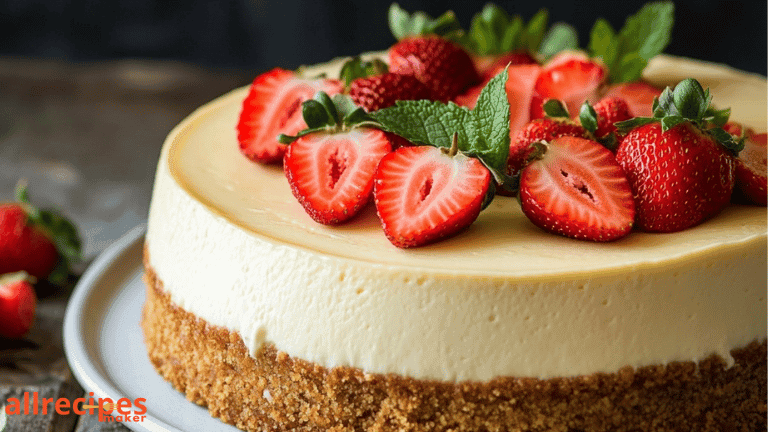How to Make a Perfect Cheesecake Every Time
The allure of cheesecake is undeniable. Its rich, creamy filling and buttery crust make it the ideal dessert for any occasion. But, let’s be honest: preparing cheesecake can be like walking a tightrope. Cracked tops, lumpy fillings, and soggy crusts may transform your sweet fantasies into a culinary nightmare.
What about the good news? With the appropriate procedures, you can consistently make a beautiful cheesecake. Whether you’re a first-timer or a cheesecake fanatic, this guide will bring you through each step, including professional recommendations and troubleshooting guidance. Are you ready to build your cheesecake masterpiece? Let us get started!
Table of Contents
Table of Contents
Anatomy of the Perfect Cheesecake
A great cheesecake includes three main components:
- The buttery, crisp crust serves as the dessert’s base.
- The highlight of the dish is the silky, creamy filling.
- A smooth, crack-free top is the sign of a well-cooked cheesecake.
Let us handle each of these components one by one.
Step 1: Make the Crust
The crust serves as both a physical and flavorful foundation for your cheesecake. Here’s how to do it exactly right:
Ingredients for the Crust
- 1 ½ cups broken digestive biscuits or Graham cracker crumbs
- 5-6 tablespoons of unsalted butter, melted
- 2 tablespoons granulated sugar
Instructions
- Crush the Crackers: Crush the crackers into tiny crumbs using a food processor or a zip-top bag and a rolling pin.
- Combine the Ingredients: In a mixing basin, combine the crumbs, melted butter, and sugar until the mixture is the consistency of wet sand.
- Press into the Pan: Cover the bottom of a 9-inch springform pan with parchment paper. Using the back of a spoon or a flat-bottomed glass, evenly distribute the crumb mixture across the bottom.
- Pre-baking (Optional): To make the crust crisp and avoid sogginess, bake it for 8-10 minutes at 350°F (175°C). Allow it to cool before filling.
Step 2: Make the Creamy Filling
The filling is the heart of your cheesecake, so get that creamy, delicious texture.
Ingredients for the Filling
- 4 (8-ounce) blocks of cream cheese, softened
- 1 cup granulated sugar
- 1 cup sour or thick cream
- 1 teaspoon vanilla essence
- 4 large eggs, room temperature
Instructions
- Soften the Cream Cheese: Let the cream cheese remain at room temperature until it softens. Cold cream cheese might cause lumps in the batter.
- Beat the Cream Cheese: Beat the cream cheese with a hand or stand mixer on medium speed until it is smooth and fluffy.
- Combine the Sugar and Vanilla: Gradually stir in the sugar and vanilla extract until well mixed.
- Add Sour Cream or Heavy Cream: Stir in the sour cream or heavy cream for added richness.
- Add the Eggs: Add the eggs one at a time, mixing on low speed each time. Avoid overmixing to prevent air bubbles that could cause cracks.
Step 3: Bake Like a Pro
Baking cheesecake is not difficult, but it does take some skill.
Use a Water Bath (Bain-Marie)
A water bath promotes uniform baking and keeps the cheesecake from drying out or splitting.
How to Do It:
- Wrap the bottom of your springform pan with 2-3 layers of heavy-duty aluminum foil.
- Place the pan in a larger roasting pan and fill it with boiling water until it comes halfway up the sides of the springform pan.
Baking Instructions
- Preheat the Oven: Preheat the oven to 325°F (170°C).
- Bake the Cheesecake: Place the cheesecake in the water bath and bake for 50-60 minutes. The cheesecake is done when the edges are firm but the center still jiggles slightly when disturbed.
- Cool gradually: turn off the oven and keep the door slightly open. Allow the cheesecake to cool in the oven for one hour.
Step 4: Cool and Chill
Cooling is just as vital as baking to achieve cheesecake perfection.
- Bring to Room Temperature: Allow the cheese-cake to remain at room temperature for an additional hour after baking.
- Cover the cheesecake and refrigerate for at least 4-6 hours, ideally overnight, for the best texture and flavor.
Troubleshooting Common Cheesecake Issues
Why Did My Cheesecake Crack?
- Cause: Overmixing, overbaking, or missing the water bath.
- Fix: Use a water bath, avoid overmixing, and check for doneness (center should jiggle slightly).
Why Is My Cheesecake Lumpy?
- Cause: Cold cream cheese or eggs.
- Fix: Always allow your components to come to room temperature before combining.
Why Is My Crust Soggy?
- Cause: Water from the bath soaked into the pan.
- Fix: Wrap the pan securely in foil or pre-bake the crust for extra rigidity.
Pro Tips for Perfect Cheesecake
- Do Not Rush the Process: Cheese-cake is a treat that requires patience.
- Experiment with Flavor: Add citrus zest, melted chocolate, or fruit toppings for variety.
- Test for Doneness the Proper Way: Avoid the toothpick test; a slight jiggle in the center is ideal.
- Choose High-Quality Ingredients: Full-fat cream cheese and fresh eggs make a difference.
Innovative Cheese-cake Variations
- Lemon Cheese-cake: Incorporate lemon juice and zest, then top with lemon curd.
- Chocolate Marble Cheese-cake: Swirl melted chocolate into the batter before baking.
- Berry Bliss Cheesec-ake: Decorate with fresh strawberries, blueberries, or raspberries.
FAQ
Can I freeze cheesecake?
Yes! Wrap it tightly with plastic wrap and aluminum foil, then freeze for up to two months. Thaw in the fridge before serving.
Can cheesecake be made without a water bath?
Yes, but a water bath greatly reduces the risk of cracking. If you skip it, bake at a lower temperature and watch closely.
How do I preserve leftover cheesecake?
Refrigerate in an airtight container for up to five days.

